The increase in population, the urbanization processes and the heavy anthropic interventions are bringing new differentiated stresses for environmental and urban systems, including socio-economic pressures and natural disasters. Nowadays the problems that societies have to address are numerous, ranging from environmental pollution to soil consumption, from the lack of water and food to the necessity of biodiversity protection and climate change reduction. Immediate and efficient solutions are needed in order to avoid the achievement of an irreversible condition. In this context, the concept of sustainability has been proposed since many years as an innovative paradigm of intervention, with the objective of limiting these problems and to mitigate their effect in the long period. As it is well known, sustainable development was defined in 1987 by the Brundtland Commission as the development that meets the needs of the present without compromising the ability of future generations. The characterizing aspect that emerges from this definition is the long-term vision, which implies the need of addressing a high degree of uncertainty. Several dimensions have been identified in the concept of sustainable development (environmental, social, economic, cultural and technological dimension) which have to coexist within an integrated perspective. More recently, the United Nations defined 17 Sustainable Development Goals (SDGs). In particular, the SDGs address the global challenges, including those related to poverty, inequality, climate, environmental degradation, prosperity, and peace and justice. These objectives are strongly interconnected among them and involve all the sustainability dimensions at a planetary scale. In the context of urban transformations, a particular role is played by the SDG 11 “Sustainable cities and communities”, which explicitly considers the relationship that exists between communities and the spaces in which they live. In the context of urban sustainability assessment, different models and frameworks have been proposed in the last years in order to support designers, planners and Decision Makers in the choices related to urban transformations.
MONDINI, G. (2019). From Brundtland Report to Sustainable Development Goals. Valori e Valutazioni. 23, pp. 129-137.
MONDINI, G., FATTINNANZI, E., OPPIO, A., BOTTERO, M., STANGHELLINI, S. (2018). Integrated Evaluation for the Management of Contemporary Cities,.Green energy and technology, pp 1-629, ISBN: 978-3-319-78270-6
MONDINI, G. (2016). Integrated assessment for the management of new social challenges. Valutazioni integrate per la gestione delle nuove sfide sociali. Valori e Valutazioni. (17), pp. 15-17.
Ecosystem services:
Due to the extremely complex and interdisciplinary nature of ecosystem services research (Daily et al. 2009), there is a need to address ecosystem services into planning practice (Luederitz et al. 2015), which requires the interrelated consideration of ecological, economic, political and social domains of knowledge (Carpenter et al. 2009; Hubacek and Kronenberg 2013). In that context, the evaluation, as a discipline, can provide tools and methodologies able to endorse a ‘value pluralism’ perspective (Gómez-Baggethun and Barton 2013) and to support the decision-making process in the definition of urban and territorial transformations.
Different values of ecosystem services may be captured and measured to inform urban and transformation planning (Gómez-Baggethun and Barton 2013): from the most common, the ecological and biophysical elements, and the economic and insurance values, to the less considered, social and cultural aspects (TEEB (The Economics of Ecosystems & Biodiversity) 2010). With particular reference to economic values, it is important to stress that the loss of ecosystem services in urban areas often involves economic costs in one form or another (TEEB (The Economics of Ecosystems & Biodiversity) 2010; European Environment Agency 2011; Bottero et al. 2020). The economic values of ES could be addressed in different ways in terms of use (direct and indirect) and non-use (option and existence) value for the different services under investigation.
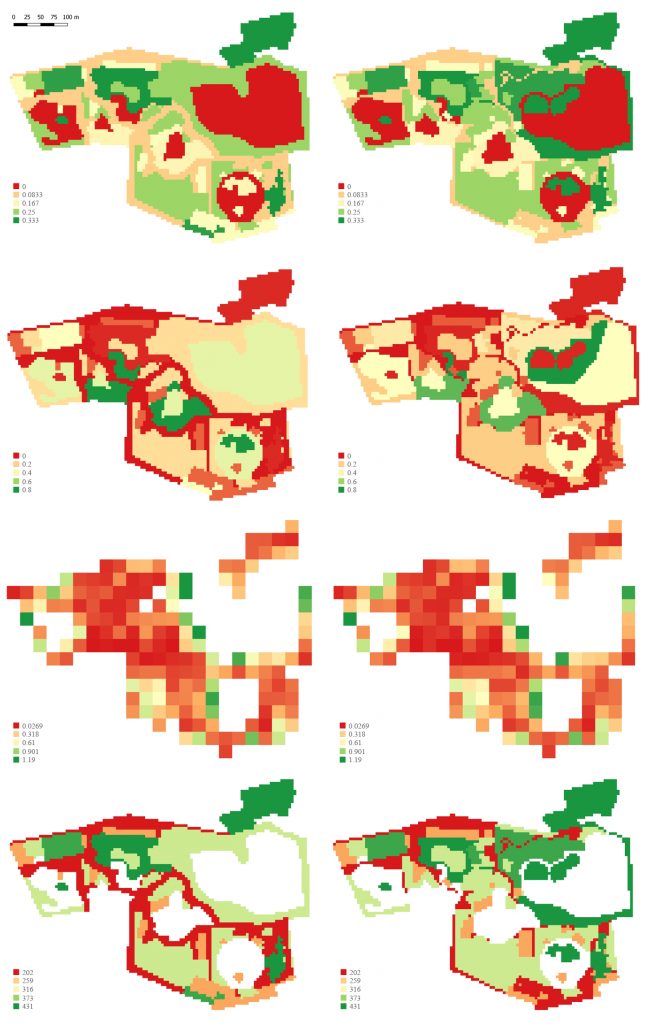
The research group supports the valuation of ecosystem services through the adoption of different evaluation tools (such as Simulsoil) and methods (Market valuation, Revealed preferences, Stated preferences) combined with Multicriteria decision analysis (MCDA).
BOTTERO M, BRAVI M, GIAIMO C, BARBIERI CA (2020) Ecosystem services: From bio-physical to economic values. Green Energy and Technology. pp 37–50
Evaluation of land take in the strategic assessment:
Soil resource has a very important role among natural resources, because it generates multiple benefits to people which live in a given environmental system (e.g. urban systems), in terms of food, energy, cultural heritage, landscape and so on; therefore it may be defined as a platform of the human life (Baveye et al. 2016; SNPA, 2019).
Perceptions on soil are changed over time, according to the people’s needs, perspectives, values, thus influencing the evolution of cities and territories: from concentric configurations to cities always faster and more connected and that will change again.
From an economic point of view, soil is an environmental good and it also may be intended as an economic one. In fact, environmental goods can be estimated through the paradigm of the Total Economic Value (TEV) by using monetary or non- monetary estimation methods (Pearce and Turner, 1991, Marangon and Tempesta, 2008).
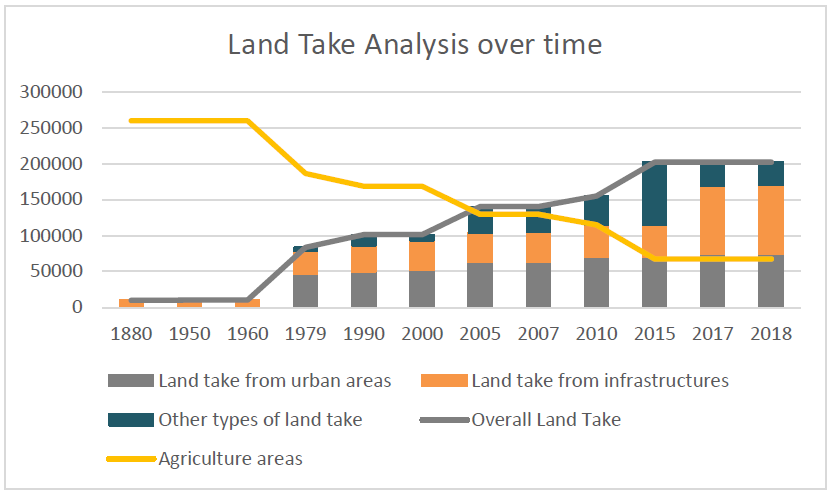
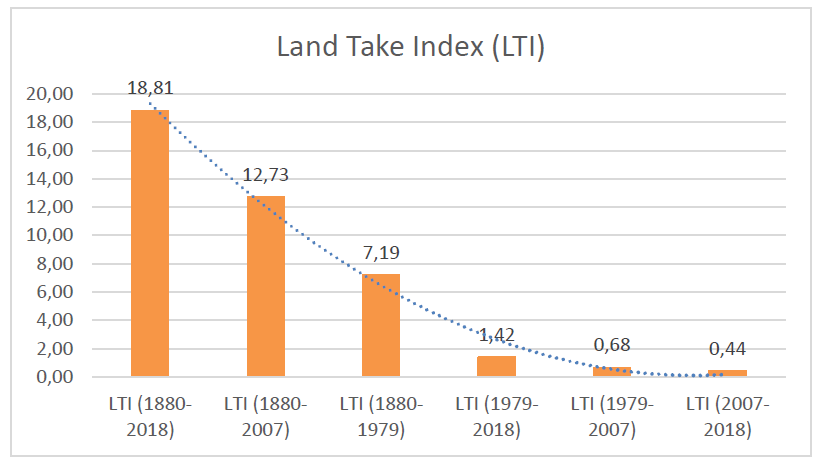
The EU Parliament and Council in 2013 defined land take as a process associated to the loss of agriculture, natural and semi-natural areas and caused mainly by urban and territorial transformations. These activities cause pressures, traducing the impacts as loss of biodiversity, ecosystem services of soil, water stress and so on.
The main challenge is to find a balance between analysis and quality of interventions to zeroing the land take until 2050 (UN 2015).
The development of integrated evaluation models, may aid the decision-making process to define specific policies and actions to enhance soil resource and limiting the land take and soil sealing impacts. More in details, the employment of integrated evaluation models aids actors, stakeholders, technicians and freelances to explore the soil dynamics over time and to estimate the economic value of compensatory actions, thus reducing the land take and soil sealing caused by transformations.
The role of GIS methods and of mathematical models applied to environmental assessment (Monaco and Soares, 2017) may give an overview of the state of the art and a possible future scenario in ecological terms.
ASSUMMA, V., BOTTERO, M., MONDINI, E., ZANETTA, E. (2021). Development of a land take evaluation of a recreative park in Northern Italy. In 4th NMP Conference, Reggio Calabria, 26-30 May 2020. In press
MONACO R. AND SOARES, A.J. (2017). A new mathematical model for environmental monitoring and assessment. From Particle Systems to Partial Differential Equations IV, Springer Proceedings in Mathematics and Statistics, pp.263-283.
Landscape evaluation:
Landscape should be recognised as a resource and therefore a variable to be considered in land use decisions. When evaluating landscapes one should use an interdisciplinary approach, should communicate with other evaluators and, importantly, recognise the academic respectability of the basic informations.
The UNITWIN/UNESCO Chairs Programme, launched in 1992, promotes international interuniversitary collaboration and networking to boost institutional capabilities through knowledge sharing and collaborative work.
A UNESCO Chair is established at Politecnico di Torino with the collaboration with the research Institute Links and the Postgraduate School of “Beni Architettonici e del Paesaggio”, which is dedicated to the management of the bio-cultural landscape, through the identification of specific models for the evaluation of cultural and landscape heritage, with a focus on economic aspects. The research, coordinated by professor Giulio Mondini, aims to develop theoretical and methodological approaches for the assessment of intangible heritage in UNESCO-recognised landscapes of excellence.
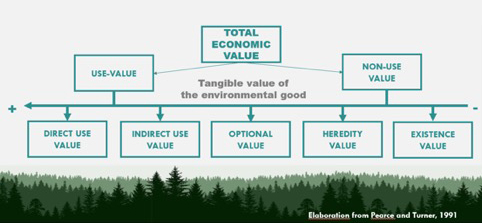
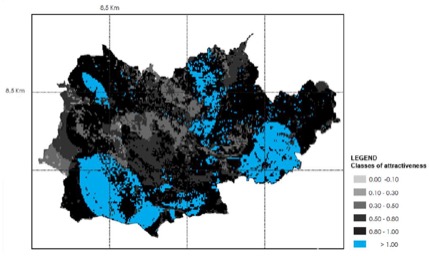
BOTTERO M. (2019), Economic Decision-Making and Urban Landscapes: A Scenario-Based Approach for the Rail Corridor in Singapore, Rinaldi B.M., Tan P. (eds.), Urban Landscapes in High-Density Cities: Parks, Streetscapes, Ecosystems, De Gruyter, Berlin, Boston, pp. 165–179.
BOTTERO M., FERRETTI V., MONDINI G. (2015), Towards an integrated economic assessment of landscape, Gambino R., Peano A. (eds.), Nature Policies and Landscape Policies, Springer, Berlin, pp. 371-380, ISBN 9783319054100.
